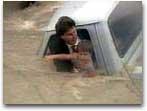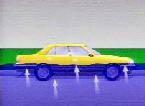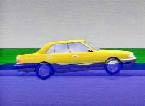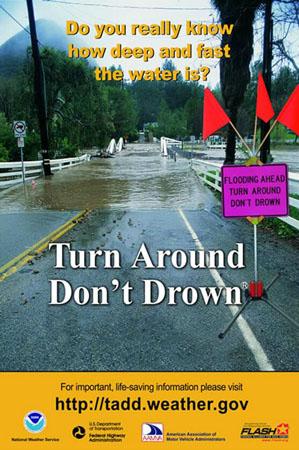Low-Water Crossings: “The Hidden Danger”
Nearly half of all flood related deaths occur in vehicles. Most of these deaths take place when people drive into flooded highway dips or low drainage areas.
A low-water crossing is where a road, without a bridge, dips across a normally dry creek bed or drainage area. Motorists who attempt to cross these flooded low-water crossings are putting themselves, their vehicles, and any other occupants of their vehicles at deadly risk.
by Gerald M. Dworkin
May 20, 1998 / revised 04/26/12 / revised 04/10/14





Nearly half of all flood related deaths occur in vehicles. Most of these deaths take place when people drive into flooded highway dips or low drainage areas.
A low-water crossing is where a road, without a bridge, dips across a normally dry creek bed or drainage area. Motorists who attempt to cross these flooded low-water crossings are putting themselves, their vehicles, and any other occupants of their vehicles at deadly risk.
Fluid Dynamics
Water weighs about 62.4 pounds per cubic foot and typically flows downstream at 6 to 12 miles an hour.
When a vehicle stalls in the water, the water’s momentum is transferred to the car. For each foot the water rises, 500 pounds of lateral force are applied to the car.
For each foot the water rises up the side of the car, the car displaces 1,500 pounds of water. In effect, the car weighs 1,500 pounds less for each foot the water rises!
Therefore, most cars will float in just two feet of water!
The Human Element
Most vehicles will become buoyant in two feet of water or less. People who have previously driven successfully through a flooded low-water crossing often do not recognize that an increase of an inch or so in the water level may be all it takes to tip the balance of buoyancy against them!
Few people, including Public Safety and Rescue personnel, appreciate the power of flowing water. Fewer people realize how fast water can rise in a small stream to flood a low-water crossing area.
More than half of all low-water crossing vehicular related deaths occur at night. Under conditions of low-visibility the vulnerability of the driver and passengers to the hidden danger is greatly magnified.
High volumes of moving water play havoc on bridges, road beds, and other structures. What may appear as a normal road, may in fact, be a death trap. Therefore, all posting warnings and barriers adhered to.
Flash Flood Warnings
A flash flood watch means flash flooding is possible within the flash flood watch area. When a flash flood watch is posted, persons in the watch area should take precautionary measures. Keep informed and be ready for quick action if flash flooding is observed or a warning is issued.
Motorists and pedestrians in or passing through the advisory area should:
- Keep abreast of road conditions through the news media.
- Avoid crossing flooded roads, and allow extra time to reach your destination.
- Avoid steep terrain where mudslides can occur.
- Be aware that heavy rainfall can reduce visibility to zero.
- Be aware that road beds may have been scoured or even washed away during flooding creating unsafe driving conditions.
- Be aware that driving too fast through low water will cause the vehicle to hydroplane and lose contact with the road surface
Dangerous Advertising
With this information in mind, we are appalled at the recent television advertising Sport Utility Vehicles. Their advertising campaigns demonstrates these particular vehicles driving through low-water crossing areas which promotes the idea that their vehicles can handle just about anything mother nature throws at them. It is our opinion that this advertising is misleading and dangerous as it presents a false sense of security to any 4 x 4 vehicle operators giving the impression that low-water crossing warnings can be ignored because their vehicles can handle any situation.
Summary
The general public, as well as Public Safety and Rescue personnel, must remember the following critical points:
- Cars and emergency vehicles can easily stall in the water and be carried away in any current!
- Most vehicles will be swept away by less than two feet of running water!
- Do not try to cross a flooded road or stream in your vehicle!
- Heed all flood and flash flood warnings issued by the National Weather Service.
- Do not drive around barricades at low-water crossings.
- Be especially vigilant at night or when traveling on unfamiliar roads.
- Do not cross flowing water.
- Observe any water level indicators at low-water crossings, remembering that six inches of water may be enough to cause you to lose control of your vehicle.
- Appreciate how fast water can rise.
- Be aware that beneath the water’s surface, road beds may have been washed away.
- If you choose to abandon your vehicle, respect the force of the water. Six inches of fast-moving water will knock you off your feet


